Baking without an oven opens up a world of possibilities, and my recent experiment with a coconut cake in a cooker proves just that. The result? A delightful, moist cake that radiates the unmistakable, rich flavor of coconut. The aroma alone is enough to draw you in, but it’s the taste that truly seals the deal: a perfect blend of sweetness and that distinct coconut essence that transports you to a tropical paradise with each bite.
The cake’s surface emerges beautifully golden, hinting at the caramelization of sugars and the toasty undertones of the coconut. For those looking for a no-fuss, no-oven baking solution, this coconut cake is a must-try. It’s a versatile recipe that could easily be adapted to include different flavors or toppings, yet it shines brightly on its own.
Whether you’re a seasoned baker or someone just dipping their toes into the world of baking, this cake is bound to become a favorite.
WHAT YOU’LL LOVE ABOUT THIS
- Perfect for Any Occasion
- Eggless
- No oven required
- Moist and Tender Texture
- Easy to make
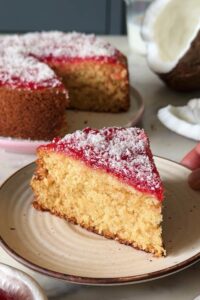
INGREDIENTS USED IN MAKING EGGLESS COCONUT CAKE IN COOKER
Butter
Butter is a primary fat source in the cake, contributing to its richness and moistness. It helps create a tender crumb by coating the flour’s proteins, which limits gluten formation. Butter imparts a subtle, creamy flavor that enhances the overall taste of the cake. It also aids in the browning process, giving the cake a beautiful golden color.
Castor sugar
Sugar is crucial for sweetening the cake and influencing its texture. It attracts and retains moisture, ensuring the cake remains soft and moist. It also aids in creating a light and airy structure by incorporating air when creamed with butter.Beyond sweetness, sugar contributes to the caramelization on the cake’s crust, adding a hint of complexity to the flavor profile.
Yogurt
Yogurt acts as a tenderizing agent and a substitute for eggs in eggless cakes. Its acidity interacts with the leavening agents (baking soda or baking powder) to produce carbon dioxide, which helps the cake rise and become fluffy.
Milk
Milk provides additional moisture and helps dissolve the dry ingredients, ensuring a smooth and cohesive batter. It also aids in the formation of the cake’s structure when combined with flour. It offers a subtle richness and creaminess that complements the other ingredients, enhancing the overall flavor.
All purpose flour
Flour is the foundational ingredient that provides structure and stability to the cake. It contains proteins that form gluten when mixed with liquids, giving the cake its shape and helping it hold together.
Desiccated coconut
Desiccated coconut adds texture and flavor to the cake. It provides a slight chewiness and enhances the cake’s moisture content. It delivers a robust coconut flavor, making the cake distinctly tropical and aromatic.
Leavening agents
Baking powder and/or baking soda are used to create air pockets in the batter, causing the cake to rise and become light and fluffy. They react with the acidic components (like yogurt) and moisture to produce carbon dioxide gas.
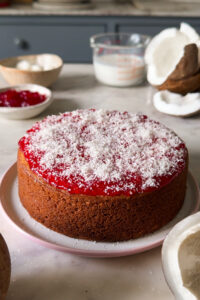
EQUIPMENT USED IN MAKING EGGLESS COCONUT CAKE IN COOKER
To combine all the ingredients for this recipe, I have used glass bowl.
Measuring Cups and Measuring Spoons. are an integral part of any baker’s kitchen and its very important to measure ingredients with precision.
I have used a 6 inch round pan to bake this cake.
A spatula and a whisk help to bring this batter together.
You’ll need a cooker in which coconut cake will get baked.
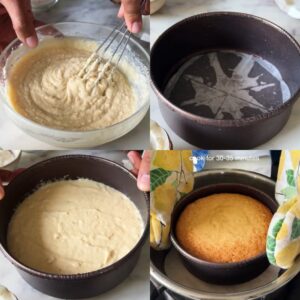
Tips to make this eggless coconut cake in cooker
- Use a large, heavy-bottomed pressure cooker without the whistle and gasket to avoid any pressure build-up. Add a layer of salt or sand at the bottom to distribute heat evenly. Preheat the cooker for 10 minutes on medium heat before placing the cake tin inside.
- Ensure that all your ingredients, especially baking powder and baking soda, are fresh. Old leavening agents can lose their potency, leading to a dense cake.
- Avoid opening the cooker frequently during baking, as this can cause the temperature to drop.
- Once the cake is baked, remove it from the cooker and let it cool in the tin for 10 minutes. Then, transfer it to a wire rack to cool completely. This prevents the cake from becoming soggy at the bottom.
- Grease the cake tin with butter or oil and line it with parchment paper. This ensures that the cake doesn’t stick to the tin and comes out easily after baking.
HOW TO BAKE IT IN THE OVEN
- Preheat oven at 180 degrees for 5-7 minutes
- Grease a 6-inch saucepan with oil and line it with parchment paper.
- Pour the batter into the prepared saucepan.
- Bake at 180 degrees for 30-35 mins or till a skewer Inserted in the centre comes out clean.
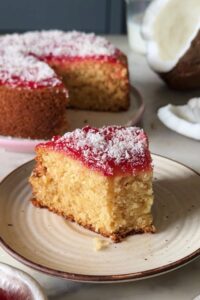
- ¼ cup butter, softened
- ½ cup sugar
- ¼ yogurt
- 6 tbsp milk, warm
- ¾ cup all purpose flour
- 6 tbsp desiccated coconut
- ½ tsp baking powder
- ½ tsp baking soda
- For garnish
- 4-5 tbsp fruit jam
- Desiccated coconut
- Spread a layer of salt at the bottom of a cooker and set it on low- medium heat.Place a hollow stand in the middle and cover the cooker with its lid . If your cooker has a rubber lining and whistle, remove it and let it pre heat for 10 minutes.
- Grease a 6 inch round pan with oil/butter and line it with parchment paper.
- Meanwhile make the cake batter by creaming butter and sugar in a bowl till it’s light and fluffy. Add yogurt and warm milk to it and whisk it together until no lumps remain.
- Lastly sift in flour, desiccated coconut, baking powder , baking soda and mix until there are no large flour pockets. Do not overmix the batter at this stage.
- Transfer the batter into the greased pan and place it carefully in the preheated cooker .
- Put the lid back on cooker and cook the cake for 30-35 minutes on low to medium heat or until a skewer inserted in the centre comes out clean.
- Once the cake has cooled down, spread an even layer of jam , sprinkle some desiccated coconut and serve.
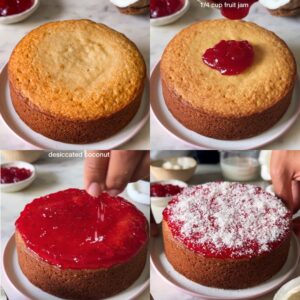
If you like my No-Oven Coconut Cake recipe and happen to make them in your kitchen, do tag me on Instagram and share pictures with me using #Bakewithshivesh. Happy Baking!

 Hello. I'm Shivesh Bhatia, a food blogger and food stylist from Delhi, India. Welcome to Bake With Shivesh, where I'll help you create magic in your kitchens with my simple recipes.
Hello. I'm Shivesh Bhatia, a food blogger and food stylist from Delhi, India. Welcome to Bake With Shivesh, where I'll help you create magic in your kitchens with my simple recipes.
Leave a Reply